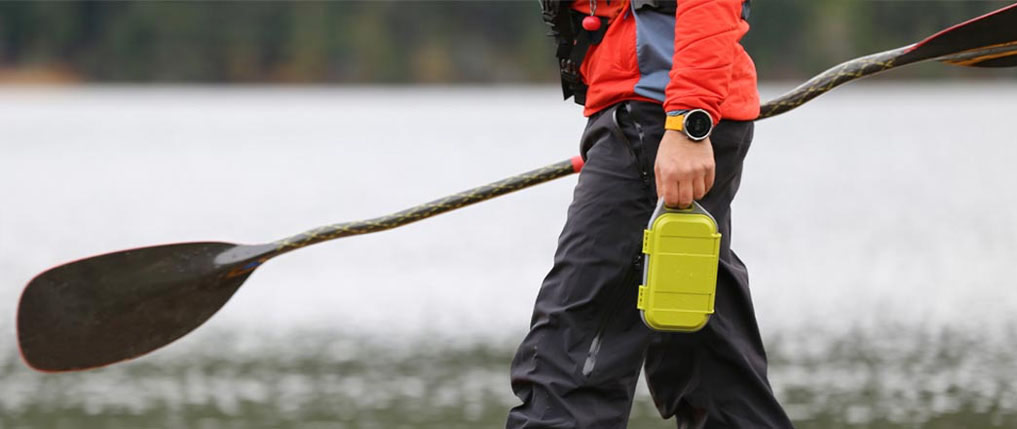The Simple Guide to Kayak and Canoe Camping
June 5, 2020

For serious outdoor adventurers, nothing brings a thrill quite like getting totally off the grid. And one of the best ways to get far off the beaten path is to paddle your way to your destination. Kayak and canoe camping combines all the best parts of outdoor fun into one big adventure. But first-timers need to be aware that this kind of camping requires a bit of extra preparation. Pelican is here to help you master it.
The Pelican G40 Personal Utility Go Case securely stores your phone and offers IP67 rated protection, meaning it’s waterproof to a depth of 1 meter for 30 minutes.
Always Be Prepared to Capsize
We don’t want to scare you, but know that even the most seasoned paddlers occasionally capsize in rough rapids. But, as long as you prep properly, tipping over is more of a moderate inconvenience than a call-it-all-off disaster. It’s vital that everything you pack is completely and totally waterproof and that you wear your personal floatation device (PFD) at all times.
Here’s how to prepare in case:
- Get a few waterproof cases. Invest in Pelican personal utility cases for your phone, camera, ID, keys and spare cash. We’ve got cases that are waterproof and float. Plus, many of our cases feature built-in carabiners so you can clip them to yourself or your pack and ensure that they stay close in the event that you tip over.
- Use a waterproof phone shell. For an extra layer of protection, make sure to use a waterproof phone case and then, to double-down, throw it in a utility case that floats. The last thing you want is to be in the middle of nowhere with no phone.
- Use bungee cords to tie down your cooler. You’re going to need to pack a watertight cooler for your beverages, ice and snacks while you’re in transit and at your campsite. Be sure to follow the basics of canoe rigging to ensure that you don’t have to go chasing after food in the event of a capsize.
- Wear your personal floatation device. It doesn’t matter how long you’ve been kayaking or canoeing, you don’t want to risk it. Always wear a U.S. Coast Guard-approved PFD to prevent disaster.
- Seal all food, medication and paper in watertight bags. This goes for the sandwiches, chips and snacks in your cooler as well as your maps, permits and other paperwork. There’s nothing worse than soggy bread or permits!
Follow the Principles of Minimalist Camping
Besides the fact that you’re subject to all kinds of wet, rough conditions, canoe and kayak camping isn’t much different than standard minimalist camping. Since you’ve only got a small amount of room to stash all your gear — tent, cooler, spare clothes, emergency supplies, etc. — you have to figure out ways to keep your footprint extra-lean.
Here are a few of our tips for how to keep it minimal:
- Limit yourself to a small bag of personal items. Your pack should contain a change of clothes, some extra socks, foul weather gear, sunscreen, bug spray, a multitool, a small first-aid kit and a personal hygiene kit with only the basics. Don’t overcomplicate packing. Pro tip: backpacks are great, but waterproof dry bags are even better at maximizing space and keeping gear dry onboard.
- Think like a backpacker. Our best advice for keeping your camping stash as lean as possible? Take a page out of the backpacker’s guidebook. They know how to pack lean. For example, they rely on calorically dense but compact foods and know exactly how to set up a shelter with lightweight, portable tents.
- Wear a headlamp. In general, anything you can wear on your body is a big win for minimalist adventuring. Rather than packing a hefty flashlight or lantern, wear a headlamp that provides targeted and ambient light.
- Prep campfire foods. Whether you plan to use pre-marinated meats, foil-wrapped baked potatoes or good-old-fashioned hot dogs, you’ve got to keep it simple. These foods ensure that you don’t need to pack any extras, including pots or pans. Just make sure your site has a grill grate or pack sticks for roasting over an open fire.
The journey is the destination, they say. In no other form of adventuring is that quite as true as with canoe and kayak camping. Be sure to follow these great tips and to ensure that you enjoy both the there and the getting there.

SIGN UP FOR EXCLUSIVE OFFERS
Sign up for our newsletter and get exclusive access to new product launches, special offers and much more.
RELATED BLOGS














